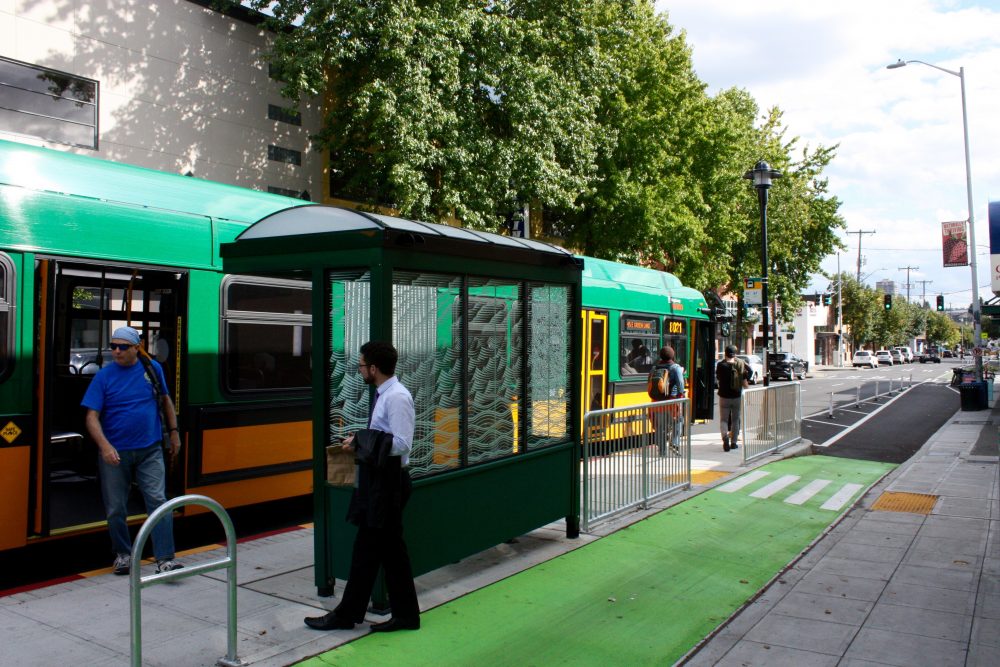
King County Metro Transit has recommended a $2.75 flat fare across its network. King County Executive Dow Constantine has endorsed the proposal and asked the King County Council to enact it. County Councilmembers Claudia Balducci and Rob Dembowski have sponsored the proposal. Despite the momentum a $2.75 flat fare, policymakers still need to grapple with the impact of raising fares 25 cents on one-zone riders off-peak.
Although a great many variables are at play, it appears some courses of action could unlock virtuous cycles. Metro Transit suggests fare simplification would speed up boarding, which in turn could save Metro Transit service hours. Faster service could also attract more riders. More riders means more revenue, which can be invested in better service.
But if a $2.75 flat fare attracts riders for its simplicity and faster boarding, wouldn’t an even simpler $2 fare provide even faster boarding and attract even more riders with not just faster boarding, but also a better deal? And would a lower fare accentuate the gains in ridership? Contrarily, would off-peak ridership take a hit under the proposed simplification given the 25 cent fare hike?
Metro Transit studied a $2.50 flat fare, but nixed it for reducing its 2020 revenue forecast by $9 million. The study did find that a $2.50 flat fare would raise annual ridership, though not by much, Metro’s Public Affairs Director Scott Gutierrez said.
“A $2.50 flat fare for full-fare adults was estimated to have a relatively minor impact on ridership, with an increase of about 300,000 annual boardings compared to our current fare structure,” Gutierrez said. “Revenue was estimated to be reduced by $9 million annually, bringing the estimated farebox recovery to 24.5 percent in 2020–compared to 26 percent under our proposal.”
Meanwhile under a $2.75 flat fare scenario, Metro’s model showed ridership decreasing slightly. 2020 ridership would drop 0.3% over a no change scenario–which translates to annual ridership decrease of about 400,000.
Ridership Modeling
Despite the projection showing ridership taking a slight hit under a $2.75 flat fare, Metro Transit thinks simplification might actually increase ridership even with some riders seeing a fare hike.
“Simplification could also impact transit ridership and use,” Gutierrez said. “Though Metro’s fare model projects a very slight decrease in ridership, the proposed fare simplification could potentially have the opposite effect. Simpler fares will likely appeal to more riders, and simplifying fare payment could speed up service and result in ridership increases or cost savings. A 2009 study by the Passenger Transport Executive Group reviewed case studies from major urban areas in Europe, North America, and Australia. The study found that fare simplification resulted in increases in ridership, some revenue increases, and decreased confusion. Metro anticipates some degree of ridership increase could occur here as well.”
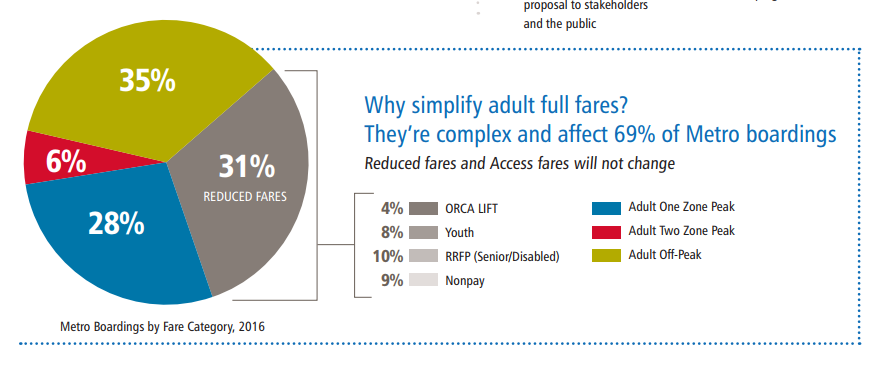
It’s a question of which effects are stronger. Two-zone riders (those crossing the city limits of Seattle) will see cheaper fares; that should drive up ridership. One-zone riders will see more expensive off-peak fares, which will likely depress ridership somewhat. And of course, simplification may have its own effect, driving up ridership through less confusion and easier marketability. Of course, larger factors out of Metro’s control may ultimately have an bigger impact, for example jumps in gas prices have historically boosted transit ridership–and the inverse is also true. (Side note: A carbon tax could help boost Metro Transit ridership by making transit more competitive with driving and internalizing some of the externalized costs of single occupant vehicles.)
How Accurate is the Modeling?
Metro Transit is confident in its ridership model. Gutierrez pointed to the Appendix C of Metro Transit’s 2014 Transit Fares Report, which showed relatively high accuracy.
“In an analysis for 2002 to 2012, we forecasted ridership in each year based on actual changes in King County employment and inflation-adjusted changes in gasoline prices and, in years without fare increase impacts, on inflation-adjusted changes in average transit fares,” Gutierrez said. “In years with fare increase impacts (2002, 2008, 2009, 2010 and 2011), ridership impacts were estimated separately. Metro’s econometric model forecasts and fare impact estimates tracked actual ridership closely, with the exception of the years 2007 and 2008. These two years saw gas prices rise above $4, as well as significant increases in local employment. These two factors coincided in a manner unprecedented in our historical data, and working together resulted in ridership increases well beyond our forecasts.”
When calculating their model’s accuracy, Metro Transit made a case for excluding the outlier year 2008, which one could argue is fair given the economic crash that year.
“Over this 11-year period, our ridership forecasts, including estimated fare change impacts, differed from actuals by an average absolute 1.8 percent. (Calculating the average absolute difference avoids the problem of positive and negative differences canceling each other out when calculating the average.) The average absolute percentage difference for the five years with fare change impacts was slightly higher–2.3 percent. Excluding 2008, the year with the most dramatic difference between forecast and actual, the average absolute percentage difference for the 10 remaining years was 1.4 percent, while the average for the four remaining fare impact years was 1.3 percent.”
While the model missing the mark by an average of 2.3 percent in fare change years sounds slight, that difference could have a significant impact on fare revenues. Metro Transit saw 121,547,395 annual boardings in 2016. A 2.3% error would mean almost 2.8 million boardings based on that number–which would seemingly throw revenue projections off by more than $5 million.
It will be interesting to see if Metro Transit’s model continues to hold up during the height of the population boom we’re experiencing. We led the nation in ridership growth last year with 4.1% year-to-year growth, although Link was instrumental in that jump. The ridership model also faces the challenge of accounting for the huge population gains Seattle has seen in recent years.
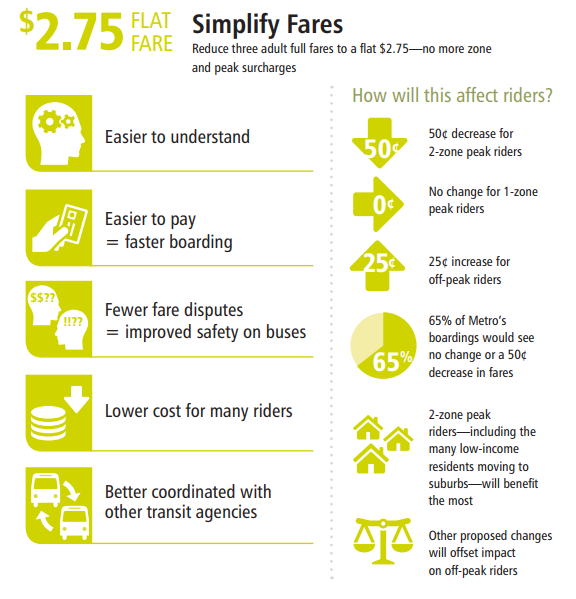
Expanding ORCA LIFT’s Role
Metro Transit has squared a flat fare with equity goals by pointing to its reduced fare programs such as ORCA LIFT. The reduced fare in these programs will stay the same under the program, insulating participants from the off-peak fare hike. More than half those eligible participate ORCA LIFT, according to Metro’s tally and an estimate of the number eligible.

“To date, 51,975 have enrolled in ORCA LIFT. Metro estimates a potential market of 66,000-86,000 eligible customers, based on Census data showing the total income-eligible population in King County, minus those who would already participate in employer pass programs, U-Pass, or disabled, youth or senior passes,” Gutierrez said. “We continue exploring ways to increase participation in and awareness of ORCA LIFT and increase access to transit.”
The almost 52,000 enrolled would suggest a participation rate of between 60% and 79%. That’s not bad–Metro Transit should seek to raise participation even higher to help more low-income transit users. Perhaps the larger issue is one the Transit Riders Union identified: the County has set a high bar to qualify.
“The US Department of Housing and Urban Development considers a family of four making $72,000 in King County to be low-income. The low-income eligibility threshold for ORCA LIFT for a family of four is less than $50,000,” General Secretary Katie Wilson said. “Many households that do not qualify for reduced transit fares are cost-burdened, and the increase from $2.50 to $2.75 will impact them. At the very least, all additional revenue from the fare restructure should be directed to programs that make transit more affordable for lower-income riders.”
Because full fares kick in below the $50,000 household income level, many families who struggle mightily with transportation and housing costs do not qualify for LIFT. The Transit Riders Union suggests a program be devised to further lower fare, perhaps raising the limit so many families qualify. This would be make the bitter pill of higher fares off-peak easier easier to swallow. Metro hasn’t yet indicated how it’d spend projected revenue increases, but the Fare Simplification Ordinance Report did respond to equity concerns.
Overall, the survey data implies that lower-income off-peak only riders will not disproportionally pay the fare increase. The survey indicates that while approximately 23 percent of all riders make less than $35,000 per year, less than 10 percent of off-peak only riders paying cash or non-subsidized ORCA fares fall into this income category. Similarly, approximately eight percent of off-peak only riders paying their own fare make between $55,000 per year and $75,000 per year, while approximately 13 percent of all riders fall within this income range.
Even if that impact is not disproportionate, one could argue the lower-income riders who do pay the higher fare will still feel it most.
Fairness and Dynamic Pricing
One factor Metro Transit tracked in its Fare Simplification Ordinance Report was whether a fare structure reflected cost of service. The flat fare proposals don’t score well in that regard because express service to and from the suburbs is more expensive to operate and typically sees weaker fare box recovery rates, particularly compared to busy Seattle routes that maintain high levels of demand all day. Express buses often suffer from one-directional demand, coming in full to downtown Seattle in the morning but not see another spike in demand until the end of the workday when workers return home. Thus, among the many things a flat fare does, one is hide the true cost of providing suburban commuter bus service.
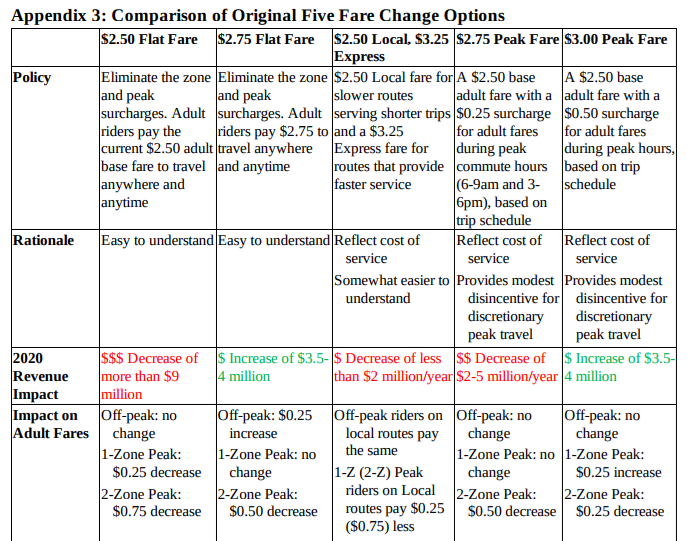
On the other hand, Washington State Department of Transportation (WSDOT) has used dynamic pricing when setting highway tolls. Crossing the SR-520 floating bridge is more expensive at peak hours, and certain express freeway lanes begin charging tolls at peak hours. A transit system shouldn’t necessarily operate the same way, but Metro Transit has at least thought about higher peak fares as a “modest disincentive for discretionary peak travel” as the chart above shows. Peak hours are when the worst bus crowding happens.
Farebox Recovery Conundrum
Despite studying a $2.50 flat fare, Metro Transit see its hands as tied by the 25% farebox recovery rate requirement the King County Counil has imposed on the agency.
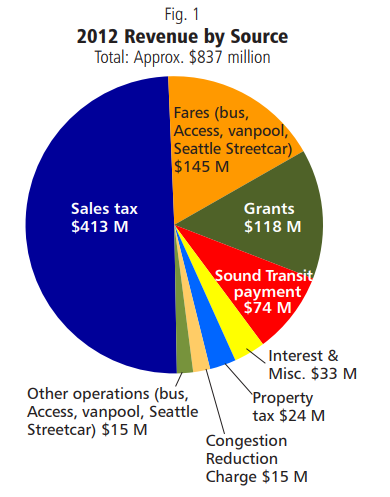
“Any proposed change to Metro’s fare structure must ensure that Metro’s farebox recovery remain above 25 percent. If a proposed change were to bring Metro’s farebox recovery under 25 percent, Metro might have to consider cutting service or delaying service adds as one way to reduce costs. A baseline forecast with no fare changes and current expenditures projects Metro’s farebox recovery ratio to be 25.9 percent by 2020. The $2.75 flat fare would increase net fare revenue by an estimated $3.5 million, or about 2.2 percent, by 2020. This would increase the farebox recovery ratio in 2020 by 0.5 percent, bringing it to 26.4 percent.”
A sensible climate strategy would likely put maximizing transit use as a higher priority than a bureaucratic benchmark for farebox recovery. Nonetheless, Metro Transit’s funding has to come from somewhere, and the State–often aided by anti-tax charlatan Tim Eyman–hasn’t done the agency any favors on that front.
“In 2016, the Council established a farebox recovery target of 30 percent and a floor of 25 percent,” Gutierrez said. “Metro is limited in terms of other funding mechanisms that are available; Metro’s largest source of funding is the sales tax, and we currently levy the maximum sales tax allowed by state law.”
As Metro Transit tries to roll out more RapidRide lines and makes big investments to upgrade bus service across its network, identifying a stable source of funding that doesn’t involve turning the screws on riders seems a must. If Seattle’s income tax prevails in court and sets a new precedent, a King County income tax would be a way to more progressively fund transit.
“I definitely think the 25% farebox recovery minimum should not be a goal in itself,” General Secretary Wilson said. “We should be looking for new progressive funding sources, and lowering fares should be the goal. Of course there needs to be a balance between lowering fares and adding service, but in general we should be incentivizing riding transit and lowering fares is a way to do that, as long as it doesn’t result in an overburdened system that people with choices don’t want to ride.”
“I think it makes a lot of sense for businesses to contribute to the transit system through taxes, in a way that would enable everyone–including workers–to have unlimited transit passes,” Wilson added.
However we do it, charting a better course for financing Metro operations would make the fare increase easier to accept in the short-term. If Metro is insistent on a flat fare, perhaps that fare can be lowered in the future when existing legal constraints are removed. That would attract more riders and increase transit’s mode share, goals that could take on a new urgency as the planet warms and climate change ramps up.
Contact information for King County Councilmembers can be found here for those looking to sway their representative.
Author’s note: The article has been updated with TRU General Secretary Katie Wilson’s comment on farebox recovery.
Doug Trumm is publisher of The Urbanist. An Urbanist writer since 2015, he dreams of pedestrian streets, bus lanes, and a mass-timber building spree to end our housing crisis. He graduated from the Evans School of Public Policy and Governance at the University of Washington in 2019. He lives in Seattle's Fremont neighborhood and loves to explore the city by foot and by bike.

